ASUS G73Jw: Out with the Old, In with the New
by Jarred Walton on November 3, 2010 12:33 AM ESTASUS G73Jw: Battery Life, Noise, Heat, and the LCD
So we’ve got the same chassis, a CPU that’s the same power spec, but a different GPU. We mentioned in the past that it appears AMD could do more to tweak the 5800 mobile parts for better battery life. Without the ability to retest notebooks months later (i.e. with the latest driver updates), all we have to go on are previous results. Battery life ends up being the one area where the G73Jw is clearly superior to the G73Jh.
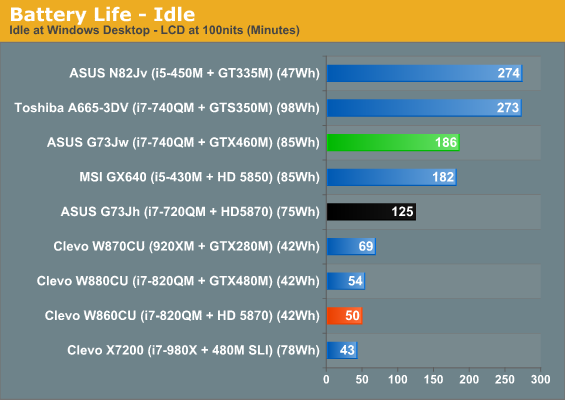
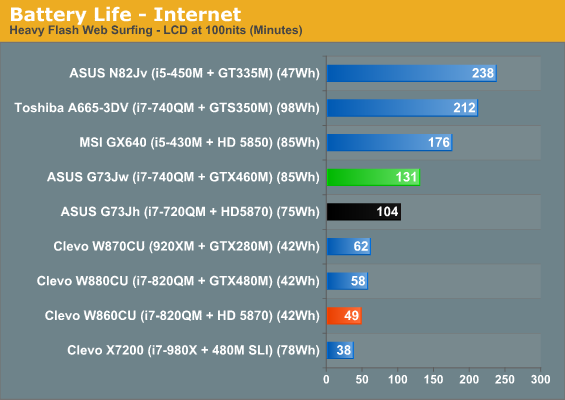
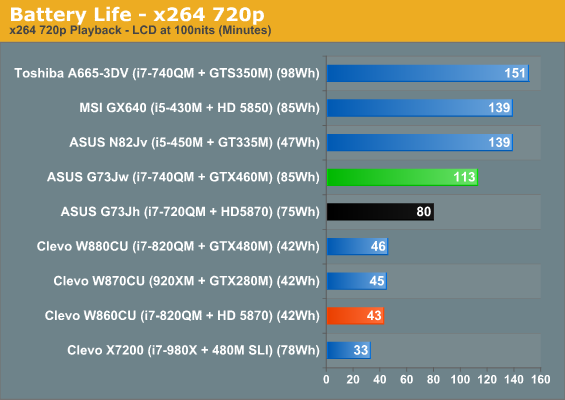
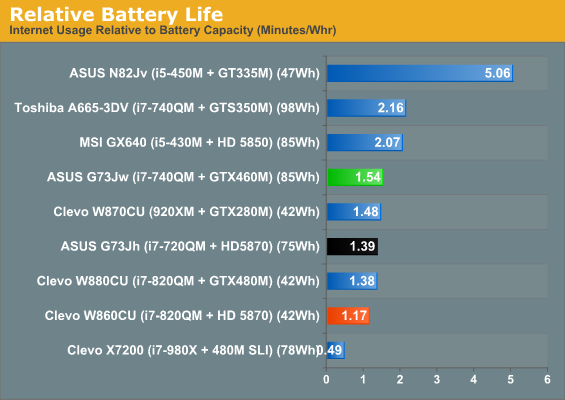
Idle battery life improves by 49%, Internet battery life is up 26%, and x264 playback is up 41%. HWMonitor even reports a wear level of 5-6% on the battery, despite over ten charge/discharge cycles, so potentially you could see even better results. However you slice it, the GTX 460M looks to be far better at idle power use than the 5870—for that matter, even the GTX 480M competes well with the HD 5870. Obviously you’re not going to buy any of the gaming notebooks as an all-day mobile solution, but it’s nice to at least get two to three hours if you need it.
If you’re interested in gaming on the battery, we also need to offer a word of caution. While we still got an hour of battery life looping 3DMark06, performance was one-third to one-fourth the speed we measured on AC power. In other words, unplug the G73Jw and the 460M suddenly starts performing like a GT 320M. That’s with the system using the highest performance options in the power settings we could select. Whether the low performance is necessary because of lack of available power from the battery, or if it’s simply a case of NVIDIA/ASUS hindering performance in order to improve battery life, unplugged the G73Jw is not going to be a gaming powerhouse.
Again we have HWmonitor reporting up to 54W of power use by a Clarksfield CPU, which is the TDP of the Extreme versions rather than the standard models. Minimum power draw for the 740QM is a massive 14W—more than some laptops use for everything at idle. Maximum CPU and GPU temperatures are very good, again highlighting how effective the G73 design is. We’re still curious as to why it’s only a 460M in the chassis, as it appears capable of handling more. Then again, perhaps it’s the power constraints rather than cooling that prevents ASUS from using something faster—and ultimately, even the mighty 480M only looks to be about 15% faster than the 460M. All things considered, the 460M looks like a good choice for the G73Jw; we’re just not convinced it’s dramatically superior to the HD 5870 in the previous model, outside of better idle power use.
The LCD: Nothing New Here
We’re not going to show detailed results for the LCD, since we’ve already seen this particular panel in the original G73Jh as well as the Clevo W880CU and X7200. It’s a good panel with an extremely high contrast ratio—we measured more than 1100:1! The down side is that maximum brightness is under 200nits, and in fact the G73Jw only manages 163nits. With such a low maximum white level, we had to double check to verify that the panel is even using LED backlighting, but it is; it’s just not particularly bright backlighting. Color accuracy and gamut are also good if not the absolute best we’ve seen. If you want to read more about the HannStar HSD173PUW1, you can refer to our G73Jh review or the X7200 review. We like the panel, but we’d still love to see a better color gamut and at least 300nits maximum brightness.


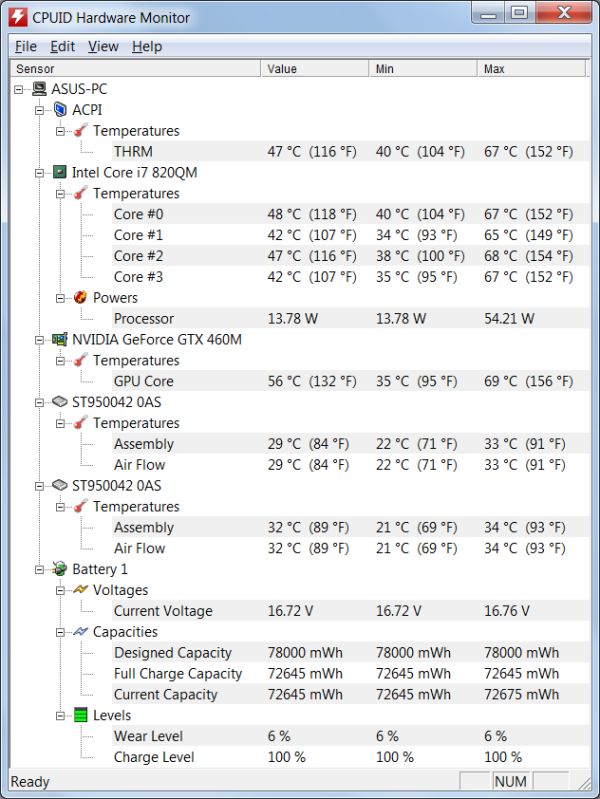








53 Comments
View All Comments
mhorn - Wednesday, November 3, 2010 - link
Great article. Are there any plans to do a review of the G53JW that just came out since it's a smaller version of the G73JW but what looks to be a big upgrade over the G51JX?Kaihekoa - Wednesday, November 3, 2010 - link
What's with all the laptop articles? There's one every few days which lately is much more often than desktop hardware. There are a dozen different components to a desktop with dozens of suppliers - how about some reviews on cases, power supplies, coolers, displays, etc. I barely visit Anandtech anymore because i seems like the only time I see a hardware review is for a major release from AMD/Intel/Nvidia/ATI.trengoloid - Wednesday, November 3, 2010 - link
the g73jw Price 1,745.03 compare to g73jw-xa1 for the price of $1,449.00 it's $300 cheaper than the g73jw and the only difference between the two is the blueray disk and 250gig and 1 year warranty and bag and mouse but remember you can upgrade theg73jw-xa1 for a better spec than the g73jw like buy a bag and mouse for just $50 and buy a hdd 1.5 gig for just &78 and external blueray drive for $90so you get the external blue ray and the built in super dvd drive. there's a lot of upgrade you can do for the price of $300 :)
Wolfpup - Wednesday, November 3, 2010 - link
It's 1120 cores, and the performance does suffer from it. If they do a mobile part, I'd expect it to be chopped down too-probably less than 800 cores. Either way I wouldn't expect it to be better than today's AMD part.JarredWalton - Wednesday, November 3, 2010 - link
Oops... corrected. I got the 5770 core count mixed up with the 6870 and somehow thought they were both 800. I've edited the final paragraph to correct the information, but ultimately the percentages are still what matters. The Northern Islands GPUs improve shader core efficiency at the same power envelope, so one NI core is worth more than one Evergreen core. Anyway, the point is that I'm not really satisfied with mobile GPU performance, at least not at the top-end.We're at less than half of what the top desktop parts can do for both AMD and NVIDIA, and I want something more than that. 5870 has 1600 cores at 850MHz and 153.6GB/s of bandwidth while Mobile 5870 has 800 cores at 700MHz with 64GB/s of bandwidth. 480 has 480 cores at 1401MHz (700MHz for the non-shader stuff) with 177.4GB/s, but 480M has 352 cores at 850MHz (425MHz non-shader) and only 76.8GB/s. That means the best single AMD mobile GPU has roughly 41% of the computational power and bandwidth; the best single NVIDIA mobile GPU has 43-45% of the computational power and bandwidth.
Yes, they also use under half the power, but Intel manages to make a mobile CPU that has about 65% of the performance of its desktop counterpart and uses less than half the power. That's the bar I want to see mobile GPUs reach: two-thirds the performance, less than half the power. Binning already gets a lot of that, so a few tweaks and refinements ought to get the rest. :-)
trengoloid - Wednesday, November 3, 2010 - link
the g73jw Price 1,745.03 compare to g73jw-xa1 for the price of $1,449.00 it's $300 cheaper than the g73jw and the only difference between the two is the blueray disk and 250gig and 1 year warranty and bag and mouse but remember you can upgrade theg73jw-xa1 for a better spec than the g73jw like buy a bag and mouse for just $50 and buy a hdd 1.5 gig for just &78 and external blueray drive for $90so you get the external blue ray and the built in super dvd drive. there's a lot of upgrade you can do for the price of $300 :)
JarredWalton - Wednesday, November 3, 2010 - link
Just to clarify a few things that you're glossing over:The mouse in the G73Jw is far nicer than a cheap $20 optical... it uses the new HP Voodoo gaming mouse, only with a different coating (to match the G73 "stealth" coating). Best price you can find for this sort of mouse is around $40-$50.
As for the bag, even a rather generic backpack is going to cost at least $30, and I'd probably value this one at $40 or more.
The single 750GB HDD looks like it's the Seagate ST9750420AS (about $120), compared to two 500GB Seagate drives ($66 each), so that's a wash really but I suppose it makes adding an SSD easier (if you can find a caddy). FWIW, the only perfect fit for the caddy right now appears to be [l=this one]http://www.asusparts.eu/product_info.php?cPath=676...[/l]. Yup, that's almost $40 for a stupid little metal tray!
Then there's the Blu-ray/DVDR combo drive. Those go for $140, not $90 (unless you just want Blu-ray and DVD reading, with no recording capabilities or you buy a refurbished/used drive).
Add all that up and the difference in price for the mouse, backpack, and BD-Combo alone is at least $220, or $260 if you count the cost of a drive caddy.
We're then left with the final item you neglected to mention: the 1-year versus 2-year warranty. I can easily see the extra year of warranty being worth $100.
So in summary, the XA1 isn't "better" and there's no "truth" behind this (thanks for the double post by the way); it's simply another option where you get exactly what you pay for. The A1 comes with all the extras for $300 more, or you can get the stripped down model with $350 less of "stuff".
JarredWalton - Wednesday, November 3, 2010 - link
Hmmm... links no longer work? Let's try again, as maybe I had the format wrong. [l=http://www.asusparts.eu/product_info.php?cPath=676...]HDD caddy[/l]XiZeL - Wednesday, November 3, 2010 - link
ohh cmon asus 60gig sandforce SSD's are so cheap now why put in 2 hard drives when you could put an SSD for system and other for storage.gc_ - Wednesday, November 3, 2010 - link
Here's a couple errors, please correct me if not:1. Table caption on first page (!)
actual: "ASUS G73Jh-A2 Specifications"
expect: ASUS G73JW-A1 Specifications
2. Battery life on fourth page
"Idle battery life improves by 49%, Internet battery life is up 26%, and x264 playback is UP 41%."
But the graphs and numbers tell a different story: x264 playback is DOWN 27.5%:
ASUS G73JH (i7-720QM + HD5870) (75wh): 80m
ASUS G73JW (i7-740QM + 460M) (85wh): 58m
(a difference in x264 decode hardware perhaps?)